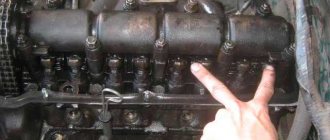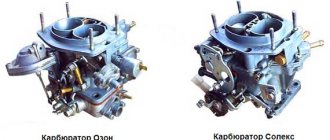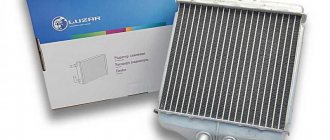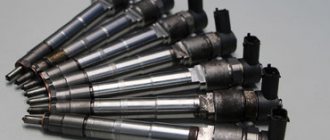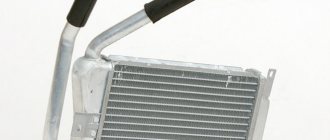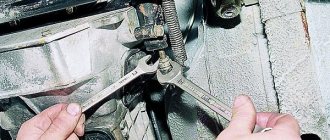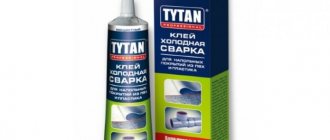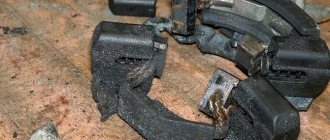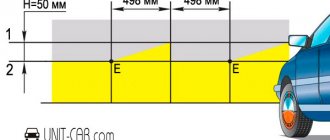The age of carburetor cars is gradually coming to an end. All over the world there are practically no manufacturing plants left that produce engines with carburetors. Nevertheless, the number of such cars is still huge, and first of all this concerns the Zhiguli classics and, of course, the sales leader of the domestic automobile industry, the VAZ 2107 - “Seven”.
Due to its design features (the presence of small parts, dependence on the purity of the fuel, many manual adjustments and a large number of functions performed during operation), a part such as a carburetor very often fails during operation. Replacing the repair kit, purging and cleaning can restore the normal functioning of the unit.
Disassembling the top
Let's start disassembling the carburetor before it was removed from the engine, by removing the filter mesh, unscrewing the fuel filter plug with an open-end wrench (19). We put all the parts in order so as not to lose them.
The mesh becomes clogged with fine rust from the tank, making its way through the fuel filter, it needs to be washed or replaced, taken from the repair kit.
Then we will continue disassembling the idle speed sensor. Having unscrewed it with an open-end wrench (12), we will look at the condition of the jet with number 50 and the movable needle under it. We will also check the operation of the sensor itself by connecting the housing to the minus terminal of the battery and the wiring to the positive terminal. When closing, the sensor “clicks” if it is in working condition.
Then we release the spring on the damper rod, as well as the “yellow” telescopic spring, pressing it inward, and disconnect it from the mount.
Unscrew the 5 screws with a Phillips screwdriver and remove the top cover.
We use a hammer to knock out the float mounting stop with a thin wrench and pull out the float along with the needle. If the valve needle is worn out, replace it from the kit and also change the paper gasket.
Then use a screwdriver to unscrew the 2 screws of the starting device and examine the condition of the rubber gasket.
On the back side of the stud, from the mounting of the air filter housing, so that it does not rotate in one place, you can lock it with an additional nut. Wash the upper half of the body with kerosene using a toothbrush and rags.
Dismantling the middle part
Before dismantling the middle part, wash the float chamber with a washing liquid, for example, acetone and wipe with a dry cloth.
Let's look at it in order:
- Using the flat blade of a screwdriver, unscrew the “nozzle” of the accelerator pump nozzle;
- We clean the thin hole of the nozzle with fishing line and blow it with a pump;
- Reassemble the nozzle in reverse order with 2 copper sealing washers and set it aside;
- Remove the small retaining ring securing the throttle valve pneumatic drive rod.
- Use a Phillips screwdriver to remove 2 screws securing the throttle valve pneumatic actuator to the middle body and examine the condition of the gasket; if the gasket is “stuck,” we will replace it;
- Using a Phillips screwdriver, unscrew the 2 screws securing the throttle body;
- Using a Phillips screwdriver, unscrew the bolt of the air damper drive rod;
- Let's separate the middle part of the case from the bottom, placing all its parts carefully to the side;
- Let's separate the thick textolite gasket that holds the two paper gaskets;
- Unscrew the 4 bolts of the accelerator pump cover and set aside the diaphragm with the spring;
- Unscrew 2 air supply jets with both hole diameters (150);
- Using a wooden pencil, draw out 2 cylinders of the air jet, which have many holes for air supply, and blow them through with a pump;
- Let's give fuel nozzles in the float bath, one with a hole diameter (112) from the small injection chamber and another (150) from the large one;
- Unscrew the accelerator pump fuel supply adjusting screw;
- Unscrew the adjusting screw for the composition of the “quality” of the idle mixture;
- We pull out the diffusers of the fuel mixture injection chambers with pliers.
Diffusers are placed with the holes facing the holes, and clamps with a rigid spring are placed on the opposite side to the chamber walls. Diffusers differ in numbers (35) for the primary chamber with a smaller diameter, and for the secondary chamber (45) with a larger diameter.
If it’s difficult to figure it out, contact carburetor specialists...
We need to disassemble all the parts to rinse them well and reassemble them in reverse order.
Working with the bottom
It remains to work with the lower part. Using a Phillips screwdriver, unscrew the 2 bolts that hold the housing with the adjusting screw and the limiting sleeve - the amount of mixture at idle. Let's check its sealing gasket and, if necessary, replace it. Let's unscrew the needle valve and check the condition of the rubber ring and, if there is a lot of wear, replace it.
Everything has been disassembled down to the screw, all that remains is to wash it with a special carburetor cleaner or acetone and reassemble it in the reverse order.
There is nothing complicated in this work, everything will shine on the outside, as well as on the inside.
What parts are included in the Solex carburetor repair kit?
If it is necessary to carry out a major overhaul of the Solex carburetor, then to ensure stable engine operation it is recommended to replace every part included in the repair kit.
The Solex carburetor repair kit consists of:
- Two fuel jets;
- Pump springs for accelerated fuel supply to the mixing chamber;
- Two emulsion tubes;
- Economizer springs;
- Needle valve assembly;
- Quality nozzle cuffs and screws;
- Screw for adjusting the quality of the working mixture;
- Carburetor cover gaskets;
- Economizer, starter and accelerator pump diaphragms;
- Strainer;
- Sprayer.
All listed parts must be installed in the device, taking care when carrying out repair work, as well as when removing them from tightly sealed packaging.
Types of service
Maintenance of Ozone carburetors can be partial or complete. The first is flushing the unit without removing it from the engine. This is done using special cleaning products such as “Carb Cleaner”. We use the product according to the instructions and continue to operate the car. But the effect of partial maintenance is short-lived and does not always help. Eventually you will have to perform a full service.
Full setup of Ozone carburetors comes down to complete disassembly of the unit, cleaning of the channels, checking the functionality of the mounted units, troubleshooting parts, assembly using spare parts and subsequent adjustment.
Stable, smooth and economical operation of any gasoline engine can only be achieved if it is provided with a perfectly balanced mixture of air and gasoline. Fuel injection systems were installed on the “Seven” only in the last years of its production. And before that, the VAZ-2107 carburetor was “out of competition”, it prepared, almost without any electronics, according to the “recipe” built into it, gasoline-air power for engines of the entire “VAZ” line. Dosage systems in devices around the world were used in a variety of ways. On the carburetors of VAZ cars, one was chosen in which a float is used to maintain a constant level. Let's look at its design and operation using the example of the DAAZ 2107-1107010 “Ozone” .
What is
The operating principle of internal combustion engines is based on the combustion of fuel, which is used for carburetor engines. The engine will not work if gasoline is simply poured into the combustion zone. Its operation is possible only when the fuel mixture enters the combustion chamber, which is formed in a ratio of 15:1 parts of air and gasoline. The carburetor just forms the composition of the fuel mixture.
New cars today are no longer produced with carburetors in the power system; they have been replaced by injectors, but the demand among car enthusiasts has remained. The production of these devices continues in many countries around the world, including the Russian Federation. During operation, these devices wear out, their adjustments are lost, so they need maintenance, adjustments, and repairs. Before we start talking about this, we should consider the design of these devices.
Replacing a VAZ 2107 carburetor with your own hands
The VAZ 2107 carburetor is removed to disassemble it or replace it with a new one if it cannot be repaired.
- After loosening the clamp, disconnect the corrugated warm air intake hose from the thermostat pipe.
Remove the filter (see Replacing the air filter element and removing the filter housing).
- Using a size 8 wrench, unscrew the four nuts securing the air filter housing to the carburetor. To avoid accidentally dropping them into the intake manifold, the carburetor can be covered with a clean cloth.
- We remove the plate.
- Loosen the clamp and remove the crankcase ventilation hose from the pipe.
- Remove the air filter housing.
- Using an “8” wrench, loosen the tightening of the bolt securing the sheath of the air damper cable...
- ... use a screwdriver to loosen the cable fastening screw, holding the nut with a “7” wrench, and remove the cable.
- Remove the crankcase gas exhaust hose from the fitting.
- We disconnect the tips of two wires from the terminals of the microswitch of the EPHH control system.
- Using a screwdriver, remove the rod from the throttle valve drive lever.
- Remove the vacuum ignition timing regulator hose from the fitting.
- Remove the hose of the electromagnetic valve of the EPHH control system from the fitting of the economizer housing.
- Remove the return spring.
- Loosen the clamp and remove the fuel supply hose.
- Using a 13mm wrench, unscrew the four nuts securing the carburetor to the intake manifold.
- Remove the carburetor from the engine.
Install the new carburetor in the reverse order of removal. We replace the gasket under the carburetor with a new one.
Do not use too much force when tightening the carburetor-to-intake manifold nuts (6.6–15.4 N•m [0.7–1.6 kgf•m]).
Settings
Before you begin, it is advisable to become more familiar with the type of carburetor used on your car. This must be done in order to select the correct repair kit for the device if necessary. There is a plate attached to the body of the middle part of the carburetor indicating its number; it is needed for the correct selection of spare parts. Settings can be made directly on the power unit or after dismantling it.
During vehicle operation, various layers of dust, dirt, and engine oil accumulate on the carburetor body, so it should be thoroughly cleaned. This procedure will be hampered by the air filter housing, which will need to be removed. First of all, unscrew the three nuts on the cover of the air filter housing with a 10mm wrench. They are removed along with the washers, after which you can remove the cover along with the air filter. The body itself is held in place with four 8mm nuts.
When the nuts are unscrewed, the housing along with the crankcase gas exhaust hoses is removed. You can start cleaning the carburetor without removing it from the engine. To do this, you can use chemicals for cleaning the engine, kerosene, and other detergents. The process will go much faster if the engine is hot. Typically, detergents come in aerosol form, making them easier to apply to dirty areas. If kerosene is used, it is poured into a plastic bottle with a small hole in the cap.
Do not use solvents for cleaning; they can damage plastic or technical rubber parts.
Signs of malfunction of the VAZ 2107 carburetor
The presence of problems in the operation of the carburetor can be judged by the following manifestations:
- “failure” when you press the gas pedal, when the car continues to move at the same speed for some time or slows down;
- “jerk” when you press the gas pedal, when the car starts to accelerate, then slows down and accelerates again;
- series of “jerks” or “failures” when moving;
- sluggish acceleration, loss of power;
- increased fuel consumption;
- difficult engine starting;
- increased or decreased idle speed;
- Rough operation or engine stalling at idle speed.
The VAZ 2107 carburetor circuit is not too complicated, so you can repair and adjust the unit yourself.
What else you should know
A mesh filter is installed in the fuel pipe of the carburetor to clean the incoming gasoline, which should be washed periodically. Some owners install an additional filter before the fuel pump, or between the pump and the carburetor.
Sometimes the idle speed “floats”, this can be caused by “excess” air passing through the gasket in the forced idle economizer, which needs to be replaced. You can use the car for some time if you insert a spring of a suitable diameter between the valve cone and the valve body, and then set the idle speed.
“Loss” of idle speed can occur after a failure of the solenoid valve. Often this can happen after the nozzle of the tip of this valve is clogged; after cleaning it, functionality is restored.
Adjusting the throttle drive
If this drive is incorrectly configured, the car's engine response drops and acceleration dynamics deteriorate. The setup is done with an assistant.
You will need the following tools: a screwdriver, an 8-mm open-end wrench, a flashlight, a ruler or a caliper.
- Turn down the “choke” (air damper drive) completely.
- Have your assistant press the gas pedal all the way to the floor. The throttle valve will open completely, as shown in the picture below, you can shine a flashlight into the first chamber. When you release the pedal, the damper should completely close the first chamber without any gaps. If there are gaps, then proceed to the next step.
- Next, we measure the length of the rod with a caliper; it should be exactly 8 cm. To adjust the length of the rod to the required size, rotate the tips by unscrewing the lock nuts.
After all these operations have been completed, put the rod in place and repeat the check. Nowadays, rods are made of low-quality plastic, which shrinks over time. Therefore, you need to check the operation of the traction after a week or two.
We looked at all the ways to adjust the carburetor yourself. We hope this article helped you, if you have any questions, ask them in the comments and we will definitely answer.
If you disassemble the carburetor to service it, you may notice a dark brown tarry coating on its internal parts, do not be alarmed. This plaque is a natural formation. It is formed as a result of the operation of forced crankcase ventilation.
And the older the engine, it has more wear, and as a result, the amount of these gases that rise in the cavity of the air filter increases, while more contamination of carburetor parts occurs. This is the relationship.
Plaque on carburetor parts and the walls that are located near them must be cleaned. But it is not necessary to clean the deposits on the walls of the neck, the walls of the dampers, and diffusers, since this deposit does not significantly affect the overall operation of the carburetor.
So don't waste your time. Although if you are a pedantic person and you have time, you can clean the carburetor to perfect cleanliness, in any case it won’t make it worse and in the future it will have a better effect on the adjustment of the VAZ 2107 carburetor.
Due to the fact that the secondary chamber of the carburetor is in operation for a short time, its secondary jet and the main air jet do not become very dirty. However, it is still necessary to check the degree of contamination.
It is recommended to do this every time you remove the carburetor cover.
It is recommended to clean the jets with either gasoline or solvent. You can use a thin wire for this.
To ensure that you do not encounter any troubles related to the operation of the carburetor along the way, every 50 - 80 thousand kilometers, check the condition of the mesh filter, which is located in the float chamber of the carburetor at the inlet.
The fact is that thanks to the effective operation of the fuel purification system of the VAZ 2107, this filter rarely becomes clogged. However, if you do not change the fine fuel filter in a timely manner, then there may be problems along the way, since this mesh filter will quickly become clogged.
All parts and cavities of the carburetor must be washed carefully. Let's say the float chamber, where there are resin deposits, it is advisable to wash it with a solvent or other effective means.
But, for example, you should only wash the diaphragms themselves and gaskets with pure gasoline, since all solvents can seriously damage them, and for this they must be washed separately.
Causes of breakdown – when to buy a repair kit?
There can be many reasons for partial or complete carburetor failure. Signs of a breakdown appear very easily - your car will not start, and fuel consumption increases noticeably while driving. In some cases, correct adjustment of the floats and jets in the chambers of the device can help. In other cases, it is necessary to use a carburetor repair kit.
Replacing parts is easy. To do this, you will need a set of standard tools, as well as carburetor flushing fluid. This liquid can be bought at any auto store, it is not that expensive. Before carrying out work, it is advisable to remove the contact terminals on the battery.
The required part is located under the car air filter cover and is attached to 4 hairpin bolts, which are screwed into the engine block. You need to unscrew them carefully enough so as not to strip the threads. Before carrying out work, it is best to treat all threaded elements with a chemical liquid that corrodes rust, for example, WD-40. After you have unscrewed the carburetor, you need to disconnect all the fuel and air hoses from it.
This is interesting: How does a refueling nozzle understand that the tank is full?
Next, place the part on a pre-prepared flat platform and let it dry a little. The device must be disassembled carefully, and, if possible, so as not to move the floats in the chambers. First of all, you need to unscrew the solenoid valve; this part is one of the most expensive in the carburetor design. After this, proceed to washing it with a chemical solution.
You need to flush the carburetor - gas stations do not always have high-quality fuel. Low-quality gasoline with its impurities contaminates the part with deposits, which subsequently affects the operation of the entire car. The grooves through which the fuel passes must be thoroughly washed. All parts must be cleaned individually. Next, let the device dry again and proceed to replacing the kit.
First of all, take the fuel jets from the carburetor repair kit - you should start with them. You need to twist them by hand, without using much physical effort. It is the fuel jets that are responsible for the uniform supply of fuel to the car’s cylinders.
Next, proceed to replacing the air jets. If the fuel accelerators of the pump look normal, then you don’t have to change them, just cleaning them will be enough. Particular attention should be paid to the fuel filter, which is located on the side of the cap on the carburetor. After you have unscrewed it, you need to wash it in acetone, then blow it under a stream of compressed air.
The fuel filter very rarely fails, so washing it will be enough. If you really want, you can replace it with a spare part from the repair kit. After a complete or partial replacement, everything needs to be adjusted and configured correctly. You can adjust the entire device yourself or go to a car repair shop, where it will be adjusted more accurately. Before final assembly and installation of the carburetor, the sealing gaskets must be treated with sealant and only after that proceed to reassembly and connection of the fuel hoses.
Adjusting the idle speed of the VAZ 2107
Well, the final part of adjusting the carburetor on the Classic is adjusting the XX. We approach the carburetor and look for the “(2) quality” and “(1) quantity” screw on it:
We unscrew the quantity screw by 3 turns, and the quality screw by 4 turns. We start the engine and let it warm up. Carburetor adjustments can only be made with the engine fully warmed up. We are waiting for 90 degrees.
After this, tighten the quality screw so that the speed drops to 700-800 rpm. In winter it can be 900-1000. After this, unscrew or tighten the quality screw so that the speed becomes the maximum possible. Then we lower the quality screw again to 700-800. After this, tighten the quality screw until the motor begins to shake slightly (barely noticeably). This will be the correct carburetor adjustment.
As you can see, the process is not complicated and you can handle it yourself!
Now let's look at how the carburetor works, ensuring the distribution of the fuel-air mixture:
- Acceleration pump.
- Econostat system.
- Maintains constant fuel level.
- Idle support.
- Support for engine starting and warming up.
- Jets (air and fuel), diffuser, VTS atomizer, well and emulsion tube are located in the main metering chamber.
The carburetor is adjusted after cleaning and assembly. Before you start disassembling and cleaning, I suggest you remember the main saying of any auto mechanic - “Don’t make a fuss while it’s quiet,” meaning that you shouldn’t get into a place where everything is in order or disassemble something that has nothing to do with the breakdown.

